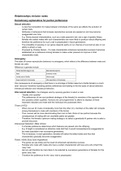Relationships revision notes
Evolutionary explanations for partner preferences
Sexual selection
- A view that competition for mates between individuals of the same sex affects the evolution of
certain traits.
- Attributes or behaviours that increase reproductive success are passed on and may become
exaggerated over time.
- E.g. Some physical characteristics, such as a male peacock’s tail, are a sign of genetic fitness,
females who select males with such characteristics are more likely to produce robust offspring and
therefore the preference for such a tail is perpetuated in future generations.
- The probability of passing on our genes depends partly on our chances of survival but also on our
ability to attract a mate.
- Proposed by Charles Darwin - If a male characteristic enhances reproductive success it becomes
established as a preference among females to males under pressure to improve on that
characteristic (trait).
Anisogamy
The basis of human reproductive behavoiur is anisogamy, which refers to the difference between male and
female sex cells.
Difference in gametes include
One consequence of anisogamy is that there is no shortage of fertile males but a fertile female is a much
rarer ‘resource’ therefore impacting partner preferences and leading to the two types of sexual selection:
Intersexual selection and Intrasexual selection.
Inter-sexual selection - the strategies used by opposing genders to select a mate
- *Quality over quantity*
- The preferences of one sex (prefered strategoy of the female) for members of the opposite sex
who possess certain qualities. Humans are ‘pre-programmed’ to attend to displays of these
important indicators and mate with the individual who possesses them.
Trivers (1972)
- When one sex (f) invets considerably more than the other (m), members of the latter will compete
among themselves to mate with members of the former
- Thus, women will be more discriminating than men in their choice of sex partner becuase the
consequences of mating with an unsuitable parter are greater.
- Therefore, the female’s optimum mating strategy is to select a genetically fit partner who is able to
provide resources.
Intersexual Selection: Mate Choice
- It is female preference determines which features are passed onto the offspring
- E.g. if height is considered an attractive male trait then it would increase/become exaggerated in
the male population over successive generations.
- This is because, in each generation, females will select the tallest males and thus that
characteristic gradually becomes exaggerated.
Fisher (1930) Sexy Sons Hypothesis
- The genes we see today are the result of enhanced reproductive success.
- Females who mate with males who have a certain characteristic will have sons who inherit this
‘sexy’ trait.
- Her son will therefore be more likely to be selected by successive generations of females for this
same ‘sexy’ trait.
- Therefore the preference for the ‘sexy’ trait is perpetuated .
,Intra-sexual selection - strategies between males to be the one selected
- “Quantity over quality”
- Where members of the same sex (prefered strategy of the male) compete with one other for
members of the opposite sex
- The winner of the competition reproduces and therefore the characteristics that contributed to his
victory may be passed on to his offspring (the losers ‘losing’ characteristics are not passed on)
- This has given rise to dimorphism - exaggeration of differences in physical characters between
males and females because of intra-sexual selection
- For example, larger males have an advantage and are therefore more likely to be
reproductively successful however females youthfulness is selected because males have
a preference to mate with younger more fertile women, as indicated by narrower waist
(0.7 waist to hip ratio) and a baby like face
- Intra-sexual selection also has behavioural consequences - the characteristics that are favoured
and passed on are those that allow a male to out compete his rivals, including deceitfulness,
intelligence and aggression.
Evaluation
Research support for inter-sexual slection/female ‘choosiness’
One strength is evidence supporting the specific role of female choosiness in heterosexual partner
preference.
Russell Clark and Eleine Hatfield (1989) sent male and female psychology students out across a university
campus. They approached other students individually with this question: ‘I have been noticing you around
campus. I find you to be very attractive. Would you go to bed with me tonight?’ Not a single female student
agreed to the request, whereas 75% of males did, immediately.
This supports the view that females are choosier than males when it comes to selecting sexual partners
and that males have evolved a different strategy to ensure reproductive success.
However -
The argument from sexual selection that one strategy is adaptive for all males and another is adaptive for
all females is simplistic. At the very least it appears that strategies differ according to the intended length of
the relationship. Sexual strategies theory (Buss and Schmitt 2016) argues that both males and females
adopt similar mating strategies when seeking long term relationships. Both sexes are very choosy and look
for partners who are loving, loyal and kind, for example.
This is a more complex and nuanced view of how evolutionary pressures influence partner preferences
which takes account of the context of reproductive behaviour.
Reserach support for intra-sexual selection
Another strength is evdiece to support the predicitons of sexual selection theory.
David Buss carried out a survey of over 10,000 adults in 33 countries. He asked questions relating to a
variety of attributes that evolutionary theory predicts are important in partner preference. He found that
females placed greater value on resource-related characteristics than males did, such as good financial
prospects and ambition. Males valued physical attractiveness and youth (as signs of good reproductive
capacity) more than females did.
These findings relfect consitent sex differences in partner preferences and support the predicitons from the
sexual seleciton theory.
Social and cultural influences underestimated
One limitation is that evolutionary theories overlook the influences of social and cultural factors on partner
preference.
Partner preferences over the past century have undoubtedly been influenced by rapid changing social
norms of behaviour. These develop much faster than evolutionary timescales imply and have instead come
about due to cultural factors (e.g. availability of contraception). Women’s greater role in the workplace
means they are no longer dependent on men to provide for them (despite the ongoing inequality in earning
power). Tamas Bereczkei et al. argue that this social change has consequences for women's mate
preferences, which may no longer be resource-oriented.
Therefore, partner preferences today are likely to be the outcome of a combination of evolutionary and
cultural influences. Any theory that fails to account for both is a limited explanation.
, Factors affecting attraction: Self Disclosure
Self disclosure - revealing personal information about yourself
- E.g. thoughts, feelings and experiences
- More disclosure = greater feelings of intimacy (positive correlation)
Altman and Taylor’s (1973) - Social Penetration Theory
- Self disclosure is a major concept within social penetration theory of how relationships develop
- As each partner increasingly reveals more information about one another (reciprocal
exchange),when one partner reveals some personal information they are signalling ‘I trust you’ and
to go further the other partner must also reveal sensitive information. As they increasingly disclose
more and more, romantic partners ‘penetrate’ more deeply into each other’s lives, gaining a
greater understanding of each other and a deeper connection.
Breadth and depth of self disclosure
- As both breadth and depth increases, romantic partners become more committed to one another.
- Low risk information is revealed early on in a relationship and high risk information comes out as
the relationship progresses.
In more detail
- According to Altman and Taylor as both breadth and depth increases, romantic partners become more committed to one
another. The researchers used the metaphor of the many layers of an onion to illustrate this process.
- We disclose a lot about ourselves at the start of a relationship, but what we reveal is superficial, mostly ‘on the surface’, like
the outer layers of an onion. It is the kind of ‘low risk’ information we would reveal to anyone, friends, co-workers, even
acquaintances. Breadth of disclosure is narrow because many topics are ‘off limits' in the early stage of a relationship. If we
were to reveal too much too soon, we might get the response ‘Too much information’, possibly even threatening the
relationship before it’s had a chance to get going.
- As the relationship develops, self disclosure becomes deeper, progressively removing more and more layers to reveal our
true selves and encompassing a wider range of topics, especially concerning those things that matter most to us.
- Eventually we are prepared to reveal intimate, high risk information - painful memories and experiences, strongly held beliefs,
perhaps even secrets.
Reis and Shaver: But there must also be reciprocity to disclosure
- As well as an increase in breadth and depth there needs to be reciprocal disclosure
- Once you have decided to disclose something that reveals your true self, hopefully your partner
will respond in a way that is rewarding, with empathy and also their own intimate thoughts and
feelings.
- So there is a balance of self disclosure between both partners in a successful romantic
relationship, which increases feelings of intimacy and deepens the relationship.
Depenetration
- The process where dissatisfied partners self disclose less as they gradually disengage from the
relationship
Evaluation
Research support
+ Sprecher & Hendrick found a correlation between self disclosure and satisfaction
+ Later found that taking turns leads to more satisfaction.
However,
- Relationship between greater self disclosure and satisfaction is merely correlational (i.e. not
necessarily a causal link)
- More satisfaction could lead to more self disclosure
- Or a third variable: TIME spent together
Real world application
+ Can be used as a tool in the real world to strengthen bonds (Hass and Stafford)
+ If those who limit communication to ‘small talk’ learn to self disclose, could bring several benefits in
terms of satisfaction and commitment in their relationship
+ 57% of homosexuals said that self disclosure was the main way to maintain and depeen
relationships
Cultural differences
- Tang et al review of research into sexual self disclosure in different cultures
- US disclose more sexual thoughts than Chinese but no difference in satisfaction
- Theory is a limited explanation as based on findings from individualistic culture and not necessarily
generalisable to other cultures.





